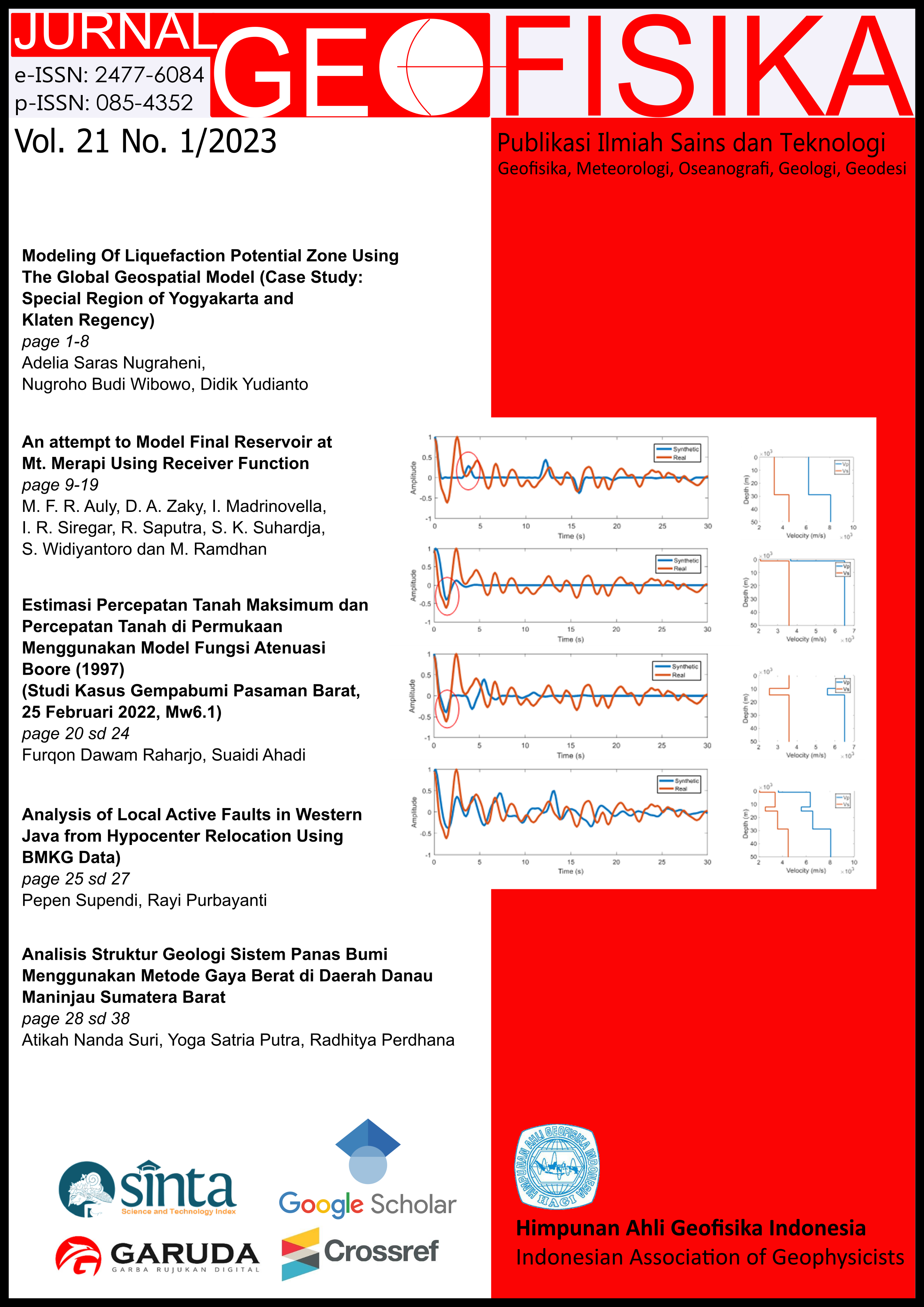Analisis Struktur Geologi Sistem Panas Bumi Menggunakan Metode Gaya Berat di Daerah Danau Maninjau Sumatera Barat
Keywords
Geothermal system, Gravity method, GGMplus, first horizontal derivative, second vertical derivativeAbstract
A geothermal system is generally associated with faults in geological structures. Therefore, identifying faults in the geothermal system is a critical study. This study aims to identify the presence of faults and to model the geological structure of a geothermal system in the Maninjau Lake area using the gravity method. Indication of the faults is determined based on gradient analysis of the first horizontal derivative (FHD) and second vertical derivative (SVD). While the subsurface structure modelling is done using forward modelling. The data used in this study is gravity disturbance data obtained on the GGMplus page. Based on the study's results, the geothermal system that developed in the Maninjau Lake area was the remnants of magma from the eruption of the Maninjau volcano. This residual magma becomes a heat source that controls the geothermal system in this area, as evidenced by the presence of volcanic rock formations in the form of basaltic andesite, pumice lapilli and basalt rock in the study area. Based on the analysis, the geological structure of the geothermal system in this area is composed of reservoir rock and cap rock. Based on the results of 2D modelling of subsurface geology, the reservoir rock consists of sandstone with a rock density of 2.76 gr/cm3 at a depth of up to 600 m. This study did not detect cover rock because it is located at a very shallow depth. The faults around the hot springs of Lake Maninjau were identified using derivative analysis. This fault can be used as a hydrothermal route for geothermal manifestations in the Maninjau Lake area. Geologically, the geothermal system in the Lake Maninjau area is included in the volcano-tectonic geothermal system.
References
Cordel, L. (1979): Gravimetric Expression of Graben Faulting in Santa Fe Country and The Espanola Basin, New Mexico. 30th Field Conf (hal. 59-64). New Mexico: Geol. Sot. Guidbook.
Direktorat, P. B. (2017): Potensi Panas Bumi Indonesia Jilid I. Jakarta: Kementerian Energi dan Sumber Daya Mineral.
Fitriani, D. S., Putri, S. N., dan Putrajy, I. F. (2020): Metode Gravitasi Untuk Identifikasi Sesar Weluki Dengan Analisis First Horizontal Derivative Dan Second Vertical Derivative. Prosiding Seminar Nasional Fisika (E-Journal) SNF2020. Jakarta: Program Studi Fisika dan Pendidikan Fisika, Fakultas MIPA, Universitas Negeri Jakarta.
Kasbani. (2009): Tipe sistem panas bumi di Indonesia dan estimasi potensi energinya. Buletin Sumber Daya Geologi, 64-73.
Nurwiyanto, M., Yustiana, M., dan Widada, S. (2006): Pengaruh ukuran butir terhadap porositas dan permeabilitas pada batu pasir. Jurnal Berkala Fisika, 191-195.
Rifaldi, R., Kristanto, A., Ristianti, N., Yuliandri, I., Koswara, I., dan Perwita, C. (2017): Pendugaan arah aliran hidrotermal dengan metode gravitasi menggunakan data citra satelit di kawasan Gunung Kelud Kabupaten Kediri. Seminar Nasional Kebumian ke-10 (hal. 1448-1462). Yogyakarta: Universitas Gadjah Mada.
Rihda, A., Hutabarat, J., Haryanto, A., Simaratama, R., dan Asoka, W. (2018): Pengaruh struktur geologi terhadap pembentukan cap rock sistim panas bumi Rindo Panti. Jurnal Padjajaran Geoscience, 201-210.
Rizkiani, D. N., dan Rustadi. (2019): Interpretasi Sistem Panas Bumi Suwawa Berdasarkan Data Gaya Berat. Jurnal Geofisika Eksplorasi.
Santoso, D. (2002): Pengantar Teknik Geofisika. Bandung: ITB.
Sari, L., Sehah, dan Hartanto. (2018): Penerapan Second Vertical Derivative (SVD) pada data gravitasi untuk mrngidentifikasi keberadaan sesar di sepanjang pegunungan Serayu Selatan Kabupaten Banyumas. Jurnal Teras Fisika, 1-7.
Suprianto, A., Supriyadi, Priyantari, N., dan Cahyono, B. (2020): Correlation between GGMplus, Topex and BGI gravity data in volacanic areas of Java Island. Journal of Physics, 1-6.
Suryanto. (2016): Identifikasi Patahan Mikro Penyebab Gempa Bumi Tarakan 21 Desember 2015. Seminar Nasional Fisika. Jakarta.

This work is licensed under a Creative Commons Attribution 4.0 International License.
The copyright of all articles belongs to the authors. All other copyrights is held by the Journal











